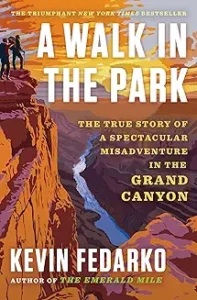A Walk in the Park: The True Story of a Spectacular Misadventure in the Grand Canyon by Kevin Fedarko 2024
I love books about challenging hikes and walks. Think Bill Bryson’s very, very funny tale of his walking the Appalachian Trail entitled “A Walk in the Woods”. Think Robert McFarlane’s “The Old Ways: A Journey on Foot” in which he channels some of the great thinkers and writers for whom walking was an integral part of their process as McFarlane walked through England and Scotland. Think Robert Moor’s “On Trails: An Exploration” who answers the question of ‘why do we hike’ by adopting Thoreau’s adage to ‘simplify’. And then there are all the books about walking that I read and reviewed last month.
So it was with great anticipation that I opened Fedarko’s book only to be mildly disappointed. Yes, there were wonderful passages in which he explored both hiking and especially the history of hiking in the Grand Canyon and there were some very funny sections (the book is often referred to as ‘hilarious’) about his misadventures, but I kept asking myself “Why?”. What is it that compels a person to leave the comforts of home and family to walk nearly 750 miles, much of it life-threatening and deeply uncomfortable, to traverse a Canyon that annually claims more than 20 lives and which you can traverse without risk and with great fun on a boat???
Along the way, we do learn some fascinating information about this earthly wonder. The Canyon, protected initially as a National Park in 1919 and expanded in 1975 to include 19,048 square miles (about 23% larger than Rhode Island) is a unique site where one can view the geologic history of the world from the surface rocks that are 270 million years old to the layer at the bottom of the Canyon clocking in at 1.84 billion years old; it’s all on view and Fedarko and his buddy, Pete McBride, saw all of it while walking, crawling, rappelling, climbing, and otherwise making their way through the trail-less Canyon. We also learn about the Native American tribes who made the Canyon and the lands at the rim their homes for centuries before the Spanish first saw it in 1540 and before John Wesley Powell traversed the length of the Colorado River in 1869. Here’s how Fedarko expressed it: “Nowhere else is the ground so broken and the past so exposed. Nowhere else can a person move simultaneously along so many dimensions: forward in space, backward in time, and across the face of an entire hemisphere of life zones, ecosystems, and biological communities. Nowhere else is the simple act of putting one foot in front of the other so provocative, so destabilizing, so densely fraught with the rich and interlocking layers of meaning.”
So, it’s clear that Fedarko can really write. If you need more proof, here’s his explanation for why embark on this project: “As a result, each excursion was brutish: the labor it demanded; the misery and anxiety it inflicted; the sheer amount of donkeywork necessary to get to the other end alive. But there was something marvelous about this obsession.” He also waxed eloquent about hiking: “The trail’s appearance stood as a reminder that among the many reasons why people love trails, perhaps the most compelling is that they offer something we all long for which is the promise to faithfully deliver us to where we need to be.”
At the end of the day and the end of the book, this is a beautifully written ode to a unique place, a wonderful friendship, the support of community and like-minded friends and a tribute to two nutty guys who finished their quest. It’s worth reading, but don’t do it for the few laughs.



